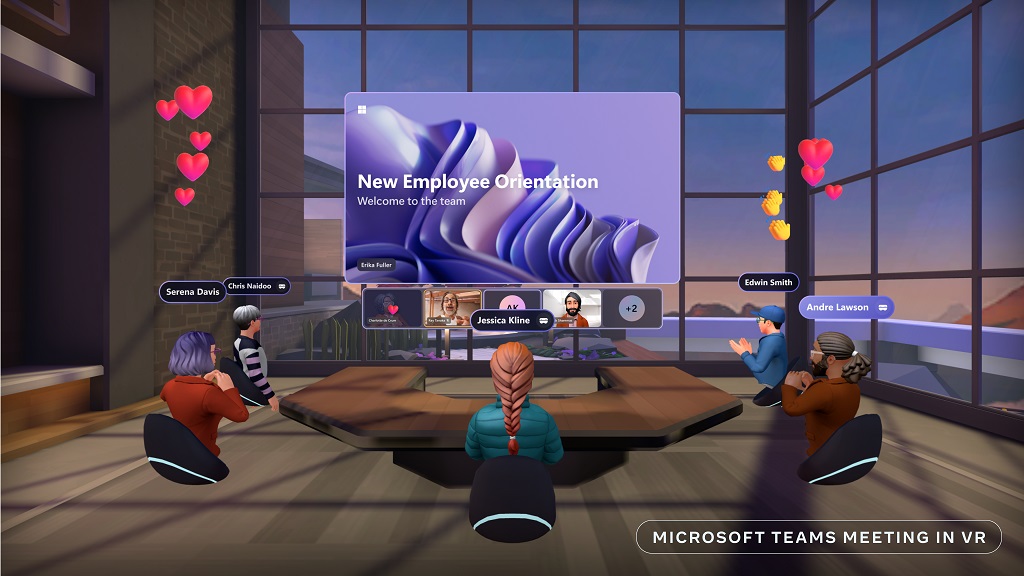In 2021, the Metaverse entered the conversation with significant hype on the decentralization web3 aspect of the Metaverse with NFT and more. A lot of innovation has happened since we discussed this topic in-depth in our November 2021 article in which we highlighted potential use cases for a Commercial Metaverse being used in the enterprise world with custom-branded corporate Metaverse worlds and brand engagement. Another interesting and emerging use case is the blend of the Industrial Metaverse with the Real-World Metaverse. Essentially leveraging a Digital Twin of our whole world as a digital content layer that is mapped to physical objects and locations with persistence, allowing it to be shared cross-platform, between devices, and over time.
At the recent Meta Connect and Microsoft Ignite conferences, the topic of the Metaverse was top of mind again. Especially professional and enterprise use cases with the announcement of the Meta Quest Pro and the Microsoft x Meta partnership, which we are going to cover in this post.

Figure 1: Satya Nadella made a surprise appearance at Mark Zuckerberg's Meta Connect keynote to announce a partnership between Meta and Microsoft.
Analysts Expect the Enterprise Metaverse to be the Route for Early Adoption
While Metaverse is still in its infancy with the puzzle pieces of AI, Spatial Computing, hyperrealism graphics and decentralized protocols like blockchain slowly maturing, but there is still a long way to go. The future looks bright though and “with its potential to generate up to $5 trillion in value by 2030, the metaverse is too big for companies to ignore”. According to Microsoft’s research, about 50% of Gen Z and Millennials envision doing some of their work in the metaverse in the next two years. The shift to remote and hybrid work models will be an accelerator for early Metaverse adoption in the enterprise providing more immersive and connected experiences. “Organizations working remotely due to the COVID-19 pandemic succeeded, by and large, at taking their knowledge workers remote. Yet the technologies that powered us through the pandemic won’t be robust enough for the long haul. Workplace collaboration using metaverse-style experiences can reduce the cognitive load generated by videoconferences — Zoom fatigue — and help employees and organizations solve a variety of collaboration problems in natural environments that mimic offices but allow deeper use of digital tools. Fifty-eight percent of business and technology professionals with knowledge of metaverses and virtual worlds report that their organization is adopting metaverse or virtual world solutions over the next 12 months to support their organization’s business or IT objectives, according to Forrester’s Priorities Survey, 2022.”
Valorem and the greater Reply network have shared our learnings and analysis at various international conferences and in the Metaverse Trend Sonar report Disentangling the value from the hype. Our proprietary Reply Sonar Trend Platform provides an overview and mapping of relevant trends related to the Metaverse based on their occurrence within expert media articles, mass media, patents, and scientific publications.

Figure 2: Trend Sonar Report Disentangling the value from the hype.
Meta x Microsoft Partnership
At the Meta Connect event, the CEO of Microsoft, Satya Nadella, made a surprise appearance in Mark Zuckerberg’s keynote and announced a new partnership between the two companies. Microsoft is bringing Mesh for Microsoft Teams to Meta Quest devices. It is designed to help people gather virtually in the place where work happens on any device, including smartphones, laptops, and Mixed Reality headsets. Additionally, Microsoft 365 will be available on Meta Quest devices including Word, Excel, PowerPoint, Outlook, and SharePoint, all within VR. Microsoft Intune and Azure Active Directory will support Meta Quest Pro and Meta Quest 2, enabling IT administrators to provision these devices, so that the security and management options they expect from PCs and mobile devices will carry over to VR.

Figure 3: Mesh for Teams Meetings in VR (Source: https://blogs.microsoft.com/blog/2022/10/11/microsoft-and-meta-partner-to-deliver-immersive-experiences-for-the-future-of-work-and-play/)
This is an important partnership in particular for enterprise customers that are usually hesitant to move to a new software platform. In fact, a lot of companies are hesitant to move to Meta software due to privacy concerns, so bringing the power of the Meta Quest Pro hardware together with Microsoft’s enterprise software stack could make this partnership really good for professional scenarios.
At Microsoft Ignite another new puzzle piece for Mesh for Teams was announced: Mesh avatars for Microsoft Teams which are currently available in a private preview only. With Mesh avatars, employees will be able to connect with presence in Microsoft Teams meetings without turning their camera on. They can represent themselves the way they want to show up by choosing the avatar that fits their specific setting, mood and meeting— from casual, professional, or day-to-day.
Figure 4: Mesh avatars for Microsoft Teams demo. (Source: https://blogs.microsoft.com/blog/2022/10/11/microsoft-and-meta-partner-to-deliver-immersive-experiences-for-the-future-of-work-and-play)
We Are Ready for the Metaverse
At Ignite many other exciting things were also announced for Azure, Microsoft 365 and the Industrial Metaverse. You can get all the news in the Ignite Book of News which is available in 11 languages here. Reply is a Featured Partner at Ignite and we also have a dedicated showcase page here where you can unlock demos, experiences and more. Additionally, we also have an on-demand Ignite session talking about the Metaverse: Feel the Metaverse with Spatial Computing and the Metaverse.
Furthermore Reply also has a dedicated Metaverse page with much more content including the new report, The Meaning of Virtual Presence in the Metaverse, which is providing an in-depth look at key elements of virtual presence: digital embodiment, avatars, decentralized identity, asset & creator economy, security and more. Speaking about security, it is also an important theme, not just at Ignite but also for us at Valorem Reply where our team of experts integrates security early and often in every digital transformation project. This topic is also becoming more and more relevant for the Metaverse as we discussed in the Virtual Presence report where identity theft and many other issues from bad actors can arise in conjunction with avatar-based systems. Therefore, it is important to address these issues early, which also includes governmental policies and regulations which will be required to make the Metaverse a safe place for everyone. In Season 2, Episode 2 of our Meta Minutes series, we recently discussed this topic with Sophia Moshasha. Find this episode and other bite-sized metaverse episodes on our blog or our Valorem Voices podcast channel.
It’s great to see the partnership between Microsoft and Meta and we are eager to see the innovation and growth as these two Metaverse powerhouses will drive by joining forces to work on interoperability for avatars between their Metaverse platforms and further collaboration. Interoperability is an important aspect of the Metaverse, if not the most important one since right now we have a Multiverse with various Metaverse platforms on the market. However, the true Metaverse vision is one Metaverse which could be a Multiverse under the hood but should appear to users in a homogenous UX as one Metaverse. Fortunately, there are initiatives like the Metaverse Standards Forum driven by the Khronos group that is fostering interoperability standards for an Open Metaverse. The Forum already has lots of members including all the big players and of course Reply is also a member, and we are excited to be a part of making the Metaverse vision a reality.
Want to understand Metaverse opportunities in your organization and industry? Valorem Reply can help you identify your highest-value investment opportunities and help you create an end-to-end plan for making metaverse a revenue-impacting asset in your business. If you are interested to hear more, please reach out to us at marketing.valorem@reply.com to schedule a dedicated time with one of our industry experts. We are a team of experts who love to solve the toughest business problems. No matter where you are on your digitalization and modernization journey, Valorem can help.
